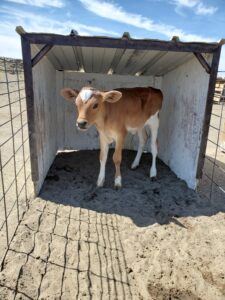You’ve probably noticed that most cows, especially here in Nevada, have number tags on their ears. These numbers serve as a lifelong identification of the cow and help farmers tell them apart, find specific cows and keep track of their herd. Additionally, you might have noticed that many cows here also wear collars. These collars are also used for identification, and more importantly for monitoring a cow’s health.
What is the Collar System?
Very simply, it’s like a fitbit for cows. The collars monitor how much time a cow spends actively eating and ruminating, as well as her general activity and inactivity time. Cows are very routine animals and they don’t tend to deviate from their routine or their baseline on a day-to-day basis. So if something does change, you know something is up–and that’s why farmers use the collars.
In the past, before advancements in technology and these collar systems came out, farmers monitored their cows just by looking at them, as well as going through and checking cows one by one which is quite tedious. With anywhere from 500 to 25,000 cows, even the best farmer could miss a small change in a single cow’s behavior. While farmers are still constantly assessing their herd, the collars bring some major benefits.
Benefits of the Collar System
The biggest benefit to the collar system is that it lets the cows spend more time being cows. It improves cow care and that’s the main focus for all of our dairy farmers. A cow can’t communicate very well. We can observe her behavior to the best of our ability, but the collar is a more effective way to know something isn’t right. We spend less time bothering every single cow and more dedicated time caring for the girls that need it.
Additionally, the collars are a great way to identify which cows are in heat. Before collars, farmers would have to check the cows daily for heat detection and breeding readiness. Now, the collars can tell them which cows are in heat based on their activity levels. When a cow is in heat, she is usually much more active. The collar sends a notification and we’re able to breed that cow. Along the same lines as heat detection, another benefit is that farmers don’t have to use as many reproductive treatments to get the cows to go into heat, because now they can identify that heat more accurately.
Connected Systems
Another benefit is that the collars are attached to the cow’s unique ID number and they can talk to other systems on the farm. An important one is the milking parlor. In the milking parlor there’s a separate milk meter system that records a cow’s milk production; however, that system will scan the collar to get an auto ID in order to connect the milk production data to the correct cow.
When the cows exit the milking parlor, there’s a gate they pass through. This gate can also read the ID on the collars. This is a helpful way to sort cows who need further attention. As the cow exits the barn, she’s scanned and if there’s a notification for her, the gate changes and she’s moved into a separate pen so the farmer and veterinarian can check her.
The collars are helpful whether they connect to other systems on the farm or not, but there’s definitely greater efficiency, value and care when the systems are connected.
The Data
When you think of monitoring 500 to 25,000 cows, 24/7– that’s a lot of data! So how can a farmer possibly review it all? The short answer is, they don’t need to.
The data from the collars sync to the main database every two hours. The database then flags any changes in individual cow data. For example, a cow typically has 10 hours of inactivity in a day. If this goes up to 13 hours, the system will throw a flag and an alarm that something is up. The farmer can then review the flags and alarms in the database to know which cows need extra care.
Like any technology and data set, there can be false positives. So it does take an experienced farmer or farm hand to review the data. Between the farmers and farmhands, the data gets reviewed at least 4-5 times per day.
The Future
Farming technology continues to evolve. It’s come a long way in a relatively short period of time and continues to improve cow care. Monitoring cows alone has gone from sending them through a squeeze shoot every day to headlocks to keep them in place to be checked to collars. The collars are much preferred by the cows and the farmers, for comfort and efficiency.
The future is AI cameras in the pens to observe the cows and their behavior. It will make collars obsolete other than identification in the milking parlor. This AI technology is already here and happening, but will be more refined and accessible within probably the next five years.
Local Coverage
Learn more about Farmers using AI with this story from 2 News KTVN.



